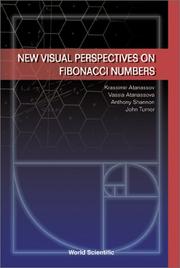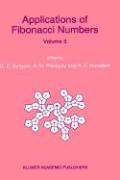| Listing 1 - 10 of 11 | << page >> |
Sort by
|

ISBN: 9812776834 9789812776839 9789812381347 9812381341 9789812381149 9812381147 9812381341 9812381147 Year: 2002 Publisher: River Edge, NJ : World Scientific,
Abstract | Keywords | Export | Availability | Bookmark
 Loading...
Loading...Choose an application
- Reference Manager
- EndNote
- RefWorks (Direct export to RefWorks)
This book covers new ground on Fibonacci sequences and the well-known Fibonacci numbers. It will appeal to research mathematicians wishing to advance the new ideas themselves, and to recreational mathematicians, who will enjoy the various visual approaches and the problems inherent in them. There is a continuing emphasis on diagrams, both geometric and combinatorial, which helps to tie disparate topics together, weaving around the unifying themes of the golden mean and various generalizations of the Fibonacci recurrence relation. Very little prior mathematical knowledge is assumed, other th
Fibonacci numbers. --- Fibonacci sequence --- Numbers, Fibonacci --- Sequence, Fibonacci --- Recurrent sequences (Mathematics) --- Number theory
Book
ISBN: 1536134554 9781536134551 1536134546 9781536134544 Year: 2018 Publisher: New York : Nova Science Publishers,
Abstract | Keywords | Export | Availability | Bookmark
 Loading...
Loading...Choose an application
- Reference Manager
- EndNote
- RefWorks (Direct export to RefWorks)
In the study of integers over many centuries, simple but very useful data have often been overlooked or at least sparingly used. The development of modular rings provides a means to shed light on such data. A modular ring is effectively an array of integers which can be uniquely identified by columns and rows with the aid of linear equations. Thus the modular ring Z4 has 4 columns (or classes), and its first two rows are 0,1,2,3 and 4,5,6,7, respectively. In turn, its columns can be identified by the classes. This notation is suggestive and transparent, and the notation itself becomes a tool of thought. The book contains a collection of readily accessible classical problems, most of which can be linked to the sequence of Fibonacci integers and explained with integer structure analysis. Modular rings are used to solve, prove and extend a variety of number theory problems associated with generalized Fibonacci numbers, golden ratio families and primes, and distinctions between prime and composite integers, as well as the classical conjectures of Brocard-Ramanujan and Erdös-Strauss. Thus (though mathematically, the golden ratio is a humble surd), replacing its argument shows that it has an infinity for close relatives that can be a source of further exploration, particularly with generalizations of Fibonacci numbers. Another important structural feature is the right-end-digit (RED) of an integer - its value modulo 10. No matter the sizes of integers, operations with their REDs are stable; for instance, the sum of the integers abcde2 and ghabj5 has a RED of 7. This stability is exploited in several chapters so that powers are reduced to 4 types in the ring modulo 4 which, for example, clarifies Fermat's Last Theorem for some powers. The context of this book is the teaching and learning of mathematics. This happens in historical and sociological contexts, and the text has sufficient historical and philosophical allusions for anyone to see that mathematics per se transcends race and religion, history and geography. The topics of number theory in the hands of well-educated teachers can inspire a love of learning in general and in mathematics in particular. For this reason, the authors have embedded relevant issues on liberal education as a foundation for education in the 21st century, particularly in fostering creativity through the inspiration and passion of teachers. Thus, the authors indicate the role of number theory as an important part of a genuine liberal education, accessible to all students today in a way that education in the ancient quadrivium was confined to a small section of society.--
Fibonacci numbers. --- Fibonacci sequence --- Numbers, Fibonacci --- Sequence, Fibonacci --- Recurrent sequences (Mathematics)

ISBN: 0792324919 9780792324911 Year: 1993 Publisher: London: Kluwer,
Abstract | Keywords | Export | Availability | Bookmark
 Loading...
Loading...Choose an application
- Reference Manager
- EndNote
- RefWorks (Direct export to RefWorks)
Book
ISBN: 0470215089 0745807151 Year: 1989 Publisher: New York Wiley
Abstract | Keywords | Export | Availability | Bookmark
 Loading...
Loading...Choose an application
- Reference Manager
- EndNote
- RefWorks (Direct export to RefWorks)
Fibonacci numbers --- Golden section --- Nombre d'or --- Fibonacci numbers. --- Golden section. --- Lucas numbers.
Book
ISBN: 9789812775832 9789812775825 9812775838 981277582X Year: 2009 Publisher: Singapore Hackensack, NJ World Scientific
Abstract | Keywords | Export | Availability | Bookmark
 Loading...
Loading...Choose an application
- Reference Manager
- EndNote
- RefWorks (Direct export to RefWorks)
Early in his rise to enlightenment, man invented a concept that has since been variously viewed as a vice, a crime, a business, a pleasure, a type of magic, a disease, a folly, a weakness, a form of sexual substitution, an expression of the human instinct. He invented gambling. Recent advances in the field, particularly Parrondo's paradox, have triggered a surge of interest in the statistical and mathematical theory behind gambling. This interest was acknowledge in the motion picture, 21, inspired by the true story of the MIT students who mastered the art of card counting to reap millions from the Vegas casinos. Richard Epstein's classic book on gambling and its mathematical analysis covers the full range of games from penny matching to blackjack, from Tic-Tac-Toe to the stock market (including Edward Thorp's warrant-hedging analysis). He even considers whether statistical inference can shed light on the study of paranormal phenomena. Epstein is witty and insightful, a pleasure to dip into and read and rewarding to study. The book is written at a fairly sophisticated mathematical level; this is not Gambling for Dummies or How To Beat The Odds Without Really Trying. A background in upper-level undergraduate mathematics is helpful for understanding this work. Comprehensive and exciting analysis of all major casino games and variants. Covers a wide range of interesting topics not covered in other books on the subject
Fibonacci numbers --- Golden section --- Mathematics --- Computer science --- History

ISBN: 0126431302 9780126431308 0080886507 1322555125 1493301926 Year: 1987 Publisher: Boston: Academic press,
Abstract | Keywords | Export | Availability | Bookmark
 Loading...
Loading...Choose an application
- Reference Manager
- EndNote
- RefWorks (Direct export to RefWorks)
Fibonacci, Leonardo (ca. 1170 ca. 1240) --- Mathematics --- Early works to 1800 --- Number theory --- Mathematics - Early works to 1800. --- Numbers, Theory of - Early works to 1800. --- Fibonacci, Leonardo, ca. 1170-ca. 1240. --- Mathématiques --- Théorie des nombres --- Fibonacci, Leonardo, --- Mathématiques - Ouvrages avant 1800 --- Théorie des nombres - Ouvrages avant 1800 --- Fibonacci, Leonardo, - environ 1170-environ 1240
Book
ISBN: 1281869953 9786611869953 9812386300 9789812386304 9781281869951 Year: 2003 Publisher: River Edge, NJ : World Scientific,
Abstract | Keywords | Export | Availability | Bookmark
 Loading...
Loading...Choose an application
- Reference Manager
- EndNote
- RefWorks (Direct export to RefWorks)
In this text, the basic mathematical properties of the golden ratio and its occurrence in the dimensions of two- and three-dimensional figures with fivefold symmetry are discussed. Fibonacci series and generalized Finobacci series and their relationship to the golden ratio are also presented.
Fibonacci numbers. --- Golden section. --- Divine proportion (Mathematics) --- Divine section (Mathematics) --- Extreme and mean ratio --- Golden cut --- Golden mean (Mathematics) --- Golden number (Ratio) --- Golden proportion --- Golden ratio --- Mean of Phidias --- Medial section --- Phi ratio --- Phidias, Mean of --- Geometry, Plane --- Ratio and proportion --- Fibonacci sequence --- Numbers, Fibonacci --- Sequence, Fibonacci --- Recurrent sequences (Mathematics)
Multi
ISBN: 9783030976002 9783030975999 9783030976019 Year: 2023 Publisher: Cham Springer International Publishing
Abstract | Keywords | Export | Availability | Bookmark
 Loading...
Loading...Choose an application
- Reference Manager
- EndNote
- RefWorks (Direct export to RefWorks)
The book takes us on a fascinating journey through one of the most beautiful and fascinating topics of mathematics. It presents a wealth of information about the golden ratio and the Fibonacci sequence. The book introduces the reader to novel perspectives to classic mathematical concepts and problems. The book’s structure engages with the reader actively, leading to more profound understanding, satisfaction and deep insights in learning mathematics. The book strengthens and expands the readers' mathematical knowledge, allowing them a glimpse of several advanced academic concepts. It demonstrates and instils the essence of mathematical research, along the lines of George Polya: observation, conjecture, proof, implementation, generalization and raising new questions.
Science --- Teacher education. Teacher's profession --- Didactics --- Teaching --- Didactics of mathematics --- didactiek --- onderzoeksmethoden --- wiskunde --- lerarenopleiding --- lesgeven --- Mathematics --- Teachers --- Learning, Psychology of. --- Education --- Mathematics Education. --- Teaching and Teacher Education. --- Learning Theory. --- Research Methods in Education. --- Study and teaching . --- Training of. --- Research. --- Ensenyament de la matemàtica --- Nombres de Fibonacci
Book
ISBN: 1282458582 9786612458583 1400831970 9781400831975 0691142483 9780691142487 0691142491 9780691142494 9781282458581 6612458585 Year: 2009 Publisher: Princeton, NJ : Princeton University Press,
Abstract | Keywords | Export | Availability | Bookmark
 Loading...
Loading...Choose an application
- Reference Manager
- EndNote
- RefWorks (Direct export to RefWorks)
Outer billiards is a basic dynamical system defined relative to a convex shape in the plane. B. H. Neumann introduced this system in the 1950's, and J. Moser popularized it as a toy model for celestial mechanics. All along, the so-called Moser-Neumann question has been one of the central problems in the field. This question asks whether or not one can have an outer billiards system with an unbounded orbit. The Moser-Neumann question is an idealized version of the question of whether, because of small disturbances in its orbit, the Earth can break out of its orbit and fly away from the Sun. In Outer Billiards on Kites, Richard Schwartz presents his affirmative solution to the Moser-Neumann problem. He shows that an outer billiards system can have an unbounded orbit when defined relative to any irrational kite. A kite is a quadrilateral having a diagonal that is a line of bilateral symmetry. The kite is irrational if the other diagonal divides the quadrilateral into two triangles whose areas are not rationally related. In addition to solving the basic problem, Schwartz relates outer billiards on kites to such topics as Diophantine approximation, the modular group, self-similar sets, polytope exchange maps, profinite completions of the integers, and solenoids--connections that together allow for a fairly complete analysis of the dynamical system.
Hyperbolic spaces. --- Singularities (Mathematics) --- Transformations (Mathematics) --- Geometry, Plane. --- Plane geometry --- Algorithms --- Differential invariants --- Geometry, Differential --- Geometry, Algebraic --- Hyperbolic complex manifolds --- Manifolds, Hyperbolic complex --- Spaces, Hyperbolic --- Geometry, Non-Euclidean --- Abelian group. --- Automorphism. --- Big O notation. --- Bijection. --- Binary number. --- Bisection. --- Borel set. --- C0. --- Calculation. --- Cantor set. --- Cartesian coordinate system. --- Combination. --- Compass-and-straightedge construction. --- Congruence subgroup. --- Conjecture. --- Conjugacy class. --- Continuity equation. --- Convex lattice polytope. --- Convex polytope. --- Coprime integers. --- Counterexample. --- Cyclic group. --- Diameter. --- Diophantine approximation. --- Diophantine equation. --- Disjoint sets. --- Disjoint union. --- Division by zero. --- Embedding. --- Equation. --- Equivalence class. --- Ergodic theory. --- Ergodicity. --- Factorial. --- Fiber bundle. --- Fibonacci number. --- Fundamental domain. --- Gauss map. --- Geometry. --- Half-integer. --- Homeomorphism. --- Hyperbolic geometry. --- Hyperplane. --- Ideal triangle. --- Intersection (set theory). --- Interval exchange transformation. --- Inverse function. --- Inverse limit. --- Isometry group. --- Lattice (group). --- Limit set. --- Line segment. --- Linear algebra. --- Linear function. --- Line–line intersection. --- Main diagonal. --- Modular group. --- Monotonic function. --- Multiple (mathematics). --- Orthant. --- Outer billiard. --- Parallelogram. --- Parameter. --- Partial derivative. --- Penrose tiling. --- Permutation. --- Piecewise. --- Polygon. --- Polyhedron. --- Polytope. --- Product topology. --- Projective geometry. --- Rectangle. --- Renormalization. --- Rhombus. --- Right angle. --- Rotational symmetry. --- Sanity check. --- Scientific notation. --- Semicircle. --- Sign (mathematics). --- Special case. --- Square root of 2. --- Subsequence. --- Summation. --- Symbolic dynamics. --- Symmetry group. --- Tangent. --- Tetrahedron. --- Theorem. --- Toy model. --- Translational symmetry. --- Trapezoid. --- Triangle group. --- Triangle inequality. --- Two-dimensional space. --- Upper and lower bounds. --- Upper half-plane. --- Without loss of generality. --- Yair Minsky.

ISBN: 0691002576 1400865182 9781400865185 9780691002583 9780691002576 0691002584 9780691002583 Year: 1998 Publisher: Princeton, New Jersey : Princeton University Press,
Abstract | Keywords | Export | Availability | Bookmark
 Loading...
Loading...Choose an application
- Reference Manager
- EndNote
- RefWorks (Direct export to RefWorks)
In 1920, Pierre Fatou expressed the conjecture that--except for special cases--all critical points of a rational map of the Riemann sphere tend to periodic orbits under iteration. This conjecture remains the main open problem in the dynamics of iterated maps. For the logistic family x- ax(1-x), it can be interpreted to mean that for a dense set of parameters "a," an attracting periodic orbit exists. The same question appears naturally in science, where the logistic family is used to construct models in physics, ecology, and economics. In this book, Jacek Graczyk and Grzegorz Swiatek provide a rigorous proof of the Real Fatou Conjecture. In spite of the apparently elementary nature of the problem, its solution requires advanced tools of complex analysis. The authors have written a self-contained and complete version of the argument, accessible to someone with no knowledge of complex dynamics and only basic familiarity with interval maps. The book will thus be useful to specialists in real dynamics as well as to graduate students.
Geodesics (Mathematics) --- Polynomials. --- Mappings (Mathematics) --- Maps (Mathematics) --- Functions --- Functions, Continuous --- Topology --- Transformations (Mathematics) --- Algebra --- Geometry, Differential --- Global analysis (Mathematics) --- Mathematics --- Absolute value. --- Affine transformation. --- Algebraic function. --- Analytic continuation. --- Analytic function. --- Arithmetic. --- Automorphism. --- Big O notation. --- Bounded set (topological vector space). --- C0. --- Calculation. --- Canonical map. --- Change of variables. --- Chebyshev polynomials. --- Combinatorics. --- Commutative property. --- Complex number. --- Complex plane. --- Complex quadratic polynomial. --- Conformal map. --- Conjecture. --- Conjugacy class. --- Conjugate points. --- Connected component (graph theory). --- Connected space. --- Continuous function. --- Corollary. --- Covering space. --- Critical point (mathematics). --- Dense set. --- Derivative. --- Diffeomorphism. --- Dimension. --- Disjoint sets. --- Disjoint union. --- Disk (mathematics). --- Equicontinuity. --- Estimation. --- Existential quantification. --- Fibonacci. --- Functional equation. --- Fundamental domain. --- Generalization. --- Great-circle distance. --- Hausdorff distance. --- Holomorphic function. --- Homeomorphism. --- Homotopy. --- Hyperbolic function. --- Imaginary number. --- Implicit function theorem. --- Injective function. --- Integer. --- Intermediate value theorem. --- Interval (mathematics). --- Inverse function. --- Irreducible polynomial. --- Iteration. --- Jordan curve theorem. --- Julia set. --- Limit of a sequence. --- Linear map. --- Local diffeomorphism. --- Mathematical induction. --- Mathematical proof. --- Maxima and minima. --- Meromorphic function. --- Moduli (physics). --- Monomial. --- Monotonic function. --- Natural number. --- Neighbourhood (mathematics). --- Open set. --- Parameter. --- Periodic function. --- Periodic point. --- Phase space. --- Point at infinity. --- Polynomial. --- Projection (mathematics). --- Quadratic function. --- Quadratic. --- Quasiconformal mapping. --- Renormalization. --- Riemann sphere. --- Riemann surface. --- Schwarzian derivative. --- Scientific notation. --- Subsequence. --- Theorem. --- Theory. --- Topological conjugacy. --- Topological entropy. --- Topology. --- Union (set theory). --- Unit circle. --- Unit disk. --- Upper and lower bounds. --- Upper half-plane. --- Z0.
| Listing 1 - 10 of 11 | << page >> |
Sort by
|

 Search
Search Feedback
Feedback About UniCat
About UniCat  Help
Help News
News